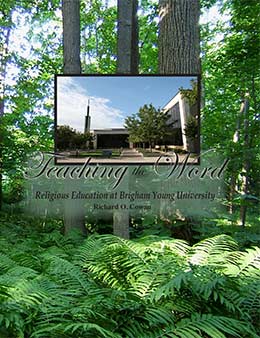A New College
1959–70
Richard O. Cowan, "A New College," Teaching the Word: Religious Education at Brigham Young University (Provo, UT: Religious Studies Center, 2008), 21–34.
On January 14, 1959, the Board of Trustees approved changing the Division of Religion to the College of Religious Instruction, headed by a dean. When the division was created in 1940, there were only five people on the religion faculty, and most classes were taught by individuals from other disciplines. With the dramatic expansion of this faculty, however, the religion teachers were able to carry the major load themselves. The expanding graduate offering also argued for college status. Nevertheless, cautioned President McKay, “we must always remember at BYU that religion is to be taught in any and all subjects and not confined to the College of Religion.” [1]
The first dean of the new college was David H. Yarn Jr., a native of Atlanta, Georgia. He earned his doctorate in education in the area of philosophy of religion at Columbia. In addition to years of administrative experience within the Division of Religion, he had served in a stake presidency as well as on both the Sunday School and Young Men’s Mutual Improvement Association general boards.
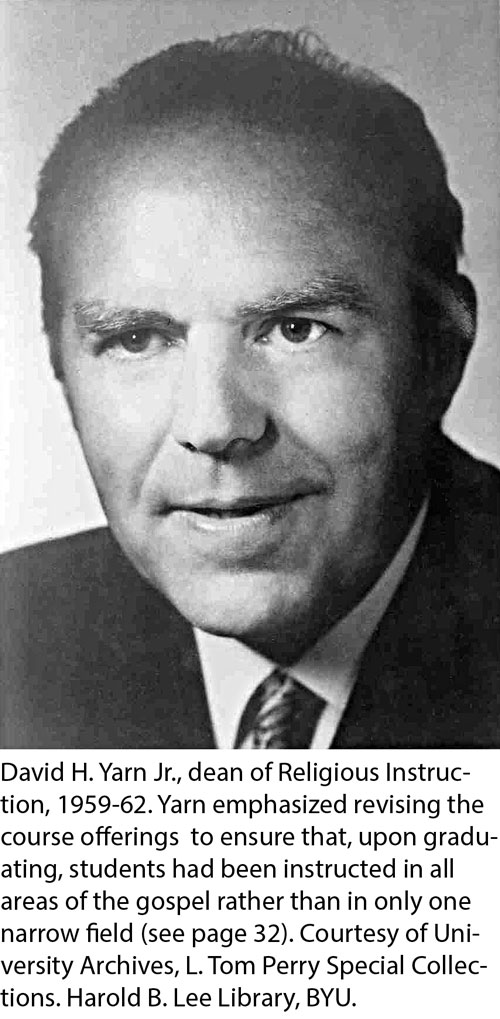
Dean Yarn recalled, “I felt it was good that the division had become a college. We had graduate classes, and certainly that was an important reason for the change. However, there was something more significant. Previous to the change, I felt that the division was regarded as less important than the colleges. The appointment of a dean, I believe, established us on an equal footing with the rest of the university.”[2]
The newly formed college immediately took steps to improve its internal organization. In the Division of Religion there had been four departments on the undergraduate level, each with a chairman. At the same time, a single director of Graduate Studies in Religion supervised four “areas” that were similar to, but not exactly the same as, the undergraduate departments. In the interest of efficiency, the new organization combined the former undergraduate departments and graduate areas into five subject-area departments, each with a chairman.
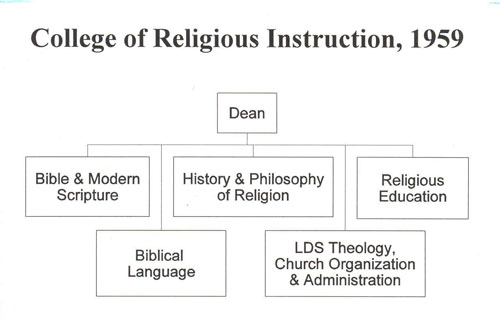
Curriculum Reorganization
BYU’s planned shift from the quarter system to semesters in 1960 provided occasion for a thorough review of the religion curriculum. This was the subject of extensive and intensive discussions in college faculty meetings during May, June, and July of 1959. During those deliberations, Dean Yarn reminded the faculty that “one of the purposes of revising the curriculum was to make sure that the courses offered . . . would be of fundamental value to the student.” He pointed out that because students take only a limited number of courses in religion, they should be encouraged to study the fundamentals of the gospel rather than narrow their studies to classes in just one field.[3]
A helpful change in numbering courses was made following a suggestion by Daniel H. Ludlow. In the past, confusion had arisen when students registered for “Religion 301,” for example, which could have been either Scripture 301 (Old Testament) or Church History 301 (LDS history). Ludlow recommended that all such duplicated course numbers be eliminated. Henceforth, the first digit in the course numbers represented the level of the course, first-year through graduate. The second digit indicated the subject areas as follows: 0, Old Testament; 1, New Testament; 2, modern scriptures; 3, theology and organization; 4, LDS history; 5, Christian history and world religion; 6, family history; 7, religious education; 8, philosophy; and 9, special courses, seminars, thesis, dissertation, and so forth. The final digit would identify specific courses.[4]
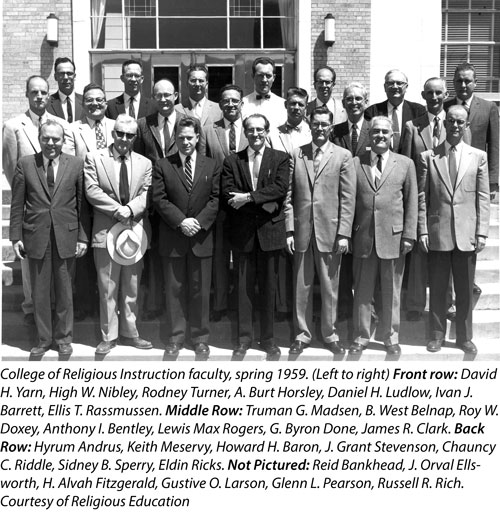
Over the years an increasing number of courses taught in such areas as archaeology, history, literature, family living, and music were given “cross-reference credit” and could therefore satisfy the religion requirement, simply because they might be related to some aspect of Church activity.[5] However, because the cross-reference credit program was difficult to administer and because the specific objective of the religion requirement was to “give the student a fundamental education of the Gospel of Jesus Christ,” university officials decided in 1960 that all such cross-referencing would be discontinued and that only courses taught in the College of Religious Instruction could fill the religion requirement.[6] This decision channeled more students into these regular religion courses.
The Basic Course
The same committee that gave consideration to cross-reference credit also recommended in May 1960 that a new basic course be created “in Doctrines and Principles of the Gospel and Practical LDS Living.”[7] While the College of Religious Instruction was taking steps to implement this decision, it was also considering another alternative—that the Book of Mormon be the basic course. The relative merits of each proposal were discussed vigorously and at great length in religion faculty meetings through the remainder of that year.
Those who favored the basic course in theology pointed out that it would provide the complete coverage of gospel principles that students needed. This course should draw from all the scriptures rather than focusing only on one and would provide a desirable broad background for subsequent study of more specific areas, such as the Book of Mormon. On the other hand, those favoring the Book of Mormon course emphasized that this book had been given as the prime instrument for converting people to Christ in this day. Focusing on this impressive book of scripture, these faculty members insisted, would give more weight to moral and ethical principles. Yet advocates of the theology course pointed out that the Book of Mormon does not treat all gospel doctrines; they also feared it could be taught more as a history of the Nephites than as America’s witness for Christ.
On March 15, 1961, Elders Harold B. Lee and Marion G. Romney of the Quorum of the Twelve strongly recommended “that the basic course required for all freshman at the Brigham Young University and in every other Church School be the ‘Book of Mormon.’ Since, as the Prophet Joseph Smith said, The Book of Mormon, ‘is the keystone of our religion,’ we think it should be taught to every student.”[8] By May, word of this decision had been relayed to the College of Religious Instruction; preparations then moved forward rapidly to provide enough teachers for the anticipated eighty to ninety Book of Mormon classes that would need to be offered that fall.[9]
Growth and Direction
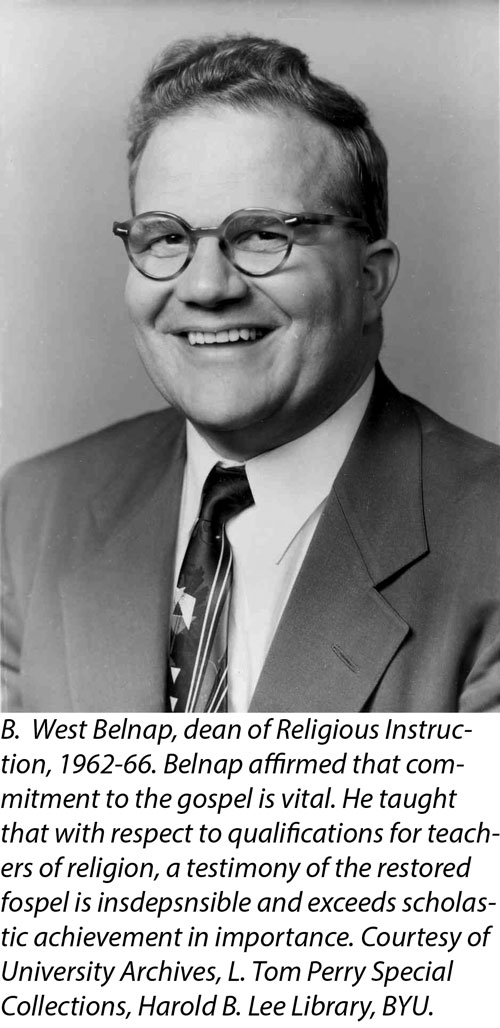
In 1962, because of illness, Dean Yarn was given an honorable release from his demanding responsibilities as dean. His successor, B. West Belnap, had served as president of a BYU stake and became executive secretary to one of the Churchwide correlation committees. His commitment to the gospel was reflected in his “Basic Fundamentals for Teachers of Religion.” In this document, he insisted that every teacher have “a testimony of the Gospel as revealed by the power of the Holy Ghost.” Teachers should have and be able to communicate an abiding faith in the actuality and literalness of gospel truths including the Fall of Adam, the Atonement and Resurrection of Jesus Christ, Joseph Smith’s First Vision and the latter-day Restoration of the gospel, the Book of Mormon’s witness for Christ, and the authority of living prophets. He believed that a testimony of these truths is essential, regardless of what scholarship or intellectual attainment we may achieve.[10]
During the four years Belnap was dean, the full-time faculty of the College of Religious Instruction increased from thirty-one to forty-one. This represented an annual growth rate of about double that of previous years. Dean Belnap therefore took steps to simplify the administrative structure.
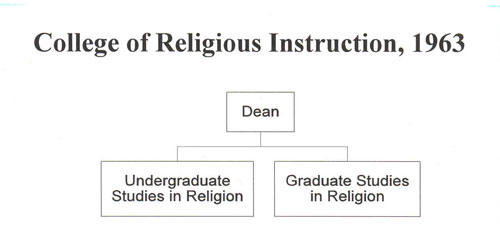
Dean Belnap underwent brain surgery in May and again in July of 1966 for the removal of a tumor, which proved to be malignant. It was apparent that his condition would not permit him to carry on his administrative responsibilities, so Roy W. Doxey was named acting dean in August. Dean Belnap died January 13, 1967. His funeral was a fittingly spiritual occasion, with Elder Harold B. Lee of the Quorum of the Twelve as one of the speakers. Members of the College of Religious Instruction faculty were invited to be honorary pallbearers.
Teaching Resources Enhanced
Daniel H. Ludlow became the next dean of Religious Instruction. In addition to being an effective administrator, he was a great teacher and teaching was his first love. He earned his master’s degree at the University of Indiana and his doctorate of education at Columbia, both in the field of curriculum materials and teaching. He was one of the original high councilors of the first BYU stake and later served in the stake presidency. In 1960 he was one of four educators whom the General Authorities called to make a comprehensive study of the Church’s curriculum and activities; for the next quarter of a century he played a key leadership role in the Church correlation program.
The popularity of basic religion classes required that many sections of each be offered. Providing syllabus materials for these classes was one of the projects which moved forward under Dean Ludlow’s leadership. The College of Religious Instruction sponsored these efforts by giving faculty members released time to prepare the various syllabi. The first of these in Book of Mormon had been prepared in 1965 by Dean Ludlow himself, and others followed for the Gospel Principles, Old Testament, New Testament, and Living Prophets courses. Likewise, the college gave released time to Ivan J. Barrett and Russell R. Rich to write their Church history texts.
Instructional television was another teaching tool developed under Dean Ludlow’s leadership. In the fall of 1965, Book of Mormon became the second BYU course to be taught by television (the basic U.S. history survey course having been offered by TV the year before). Students in three experimental sections viewed two television lectures per week and met one additional hour for discussion with a live teacher. In 1968 the format was changed to include one TV presentation and one live session per week, bringing this course in line with the number of hours spent in other two-credit classes. During that year twenty-eight Church history TV lectures were also developed under the direction of LaMar C. Berrett. Both teachers and students, however, regarded impersonality of the television medium as a particularly serious handicap in teaching religion, where sharing faith and testimony must accompany factual information. Since that time television has been used only in brief segments to enrich regular classes
I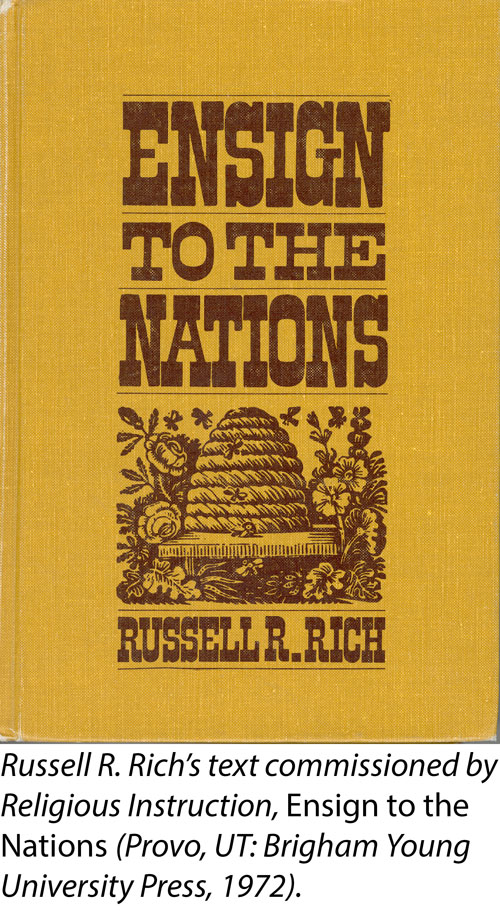
Dean Ludlow proposed another important resource for religion teachers. Traditionally faculty members could elect a sabbatical leave of either one year at half salary or one semester at full pay for additional study, often at some other university. However, this released time for additional study was not generally a meaningful option, especially for those teaching uniquely Latter-day Saint subjects. Dean Ludlow, who had experienced the stimulation of travel in the Holy Land, organized a new kind of sabbatical leave consisting of a two-month study tour in the Bible lands with all expenses paid. In the summer of 1968, under the personal leadership of Dean Ludlow, faculty members visited points of interest in Italy, Greece, Turkey, Egypt, Jordan, and Lebanon and spent three weeks in Israel. Similar programs were conducted in subsequent years, and in 1974 Paul R. Cheesman conducted a six-week tour to the lands of the Book of Mormon in Latin America. These programs were forerunners to a wide array of travel-study experiences sponsored for faculty members in later years.
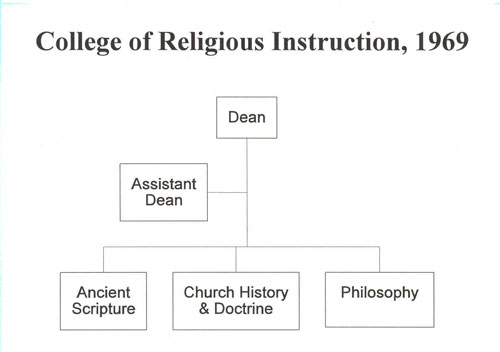
Administration and Curriculum Streamlined
In 1963 the college had been divided into only two departments—Graduate and Undergraduate Studies in Religion—to facilitate scheduling of classes. In 1969, however, a faculty committee recommended the reestablishment of subject-matter departments to maximize opportunities for association and exchange among faculty members sharing a common interest in course content and methodology. Hence the departments of Ancient Scripture, Church History and Doctrine, and Philosophy came into being.[11] Four “area coordinators” were named to give further emphasis to inservice training and mutual strengthening of the faculty in their respective fields.
Roy W. Doxey was appointed to the new position of assistant dean with responsibility for such internal matters as classroom teaching and scheduling, while the dean retained responsibility for matters which must be taken to the university administration such as rank, salaries, and leaves. This move now made it possible for the dean to teach classes on a limited basis.
A further streamlining of the curriculum in 1970 followed the principles Dean Yarn had enunciated a decade earlier. While retaining “sufficient latitude in the curriculum to allow for the diversity of background and interest among students,” these changes eliminated “duplicate and overlapping courses” that had enabled a student “to concentrate his religious studies in one area at the expense of the remainder of our rich scriptural, historical and doctrinal heritage.”[12] The reduction of total undergraduate courses by about one-fourth not only brought greater efficiency but also channeled enrollment into the more basic areas of gospel study.
In 1972 the religion requirement for graduation was clarified. As early as 1913 the faculty had passed a resolution that all students be required to take a class in theology.[13] Then, when the Division of Religion was organized in 1940, the Board of Trustees increased the requirement to two hours of religion for each quarter at BYU.[14] This meant that students should “study religion contemporaneously with . . . other academic disciplines” rather than “accumulating excessive religion credit in one semester in order to be excused from religion another semester.”[15]
At this time the Board of Trustees also modified and clarified the basic religion requirement. In 1972 the board reaffirmed the 1940 requirement of two credit hours for each semester at BYU but reduced the total graduation requirement from sixteen to fourteen semester hours. The granting of credit for attendance at devotionals (which had been allowed on a limited basis since 1960) was discontinued. To avoid “stockpiling” of religion credit, the board specified that only three hours per semester could be counted toward graduation. Finally, to meet the needs especially of seniors and graduate students, varied special one-hour courses or seminars were inaugurated.[16]
Notes
[1] Ernest L. Wilkinson, memorandum of conference with the First Presidency, January 15, 1959.
[2] David H. Yarn, interview by Richard Neitzel Holzapfel, April 22, 2008.
[3] College faculty meeting minutes, May 28, 1959.
[4] College faculty meeting minutes, April 2, 1959.
[5] Department chair meeting minutes, December 12, 1958.
[6] “Report of Committee on Requirements of Religion and their Relationship to the General Education Requirements,” May 1960, 2; Wilkinson to BYU faculty, July 11, 1960.
[7] General Education Committee Report, May 1960, 2.
[8] Harold B. Lee and Marion G. Romney to the Church Board of Education and BYU Board of Trustees, March 15, 1961.
[9] Department chair meeting minutes, May 12, 1961.
[10] Religious Instruction faculty workshop minutes, September 17, 1963.
[11] “Departmental Reorganization and Curriculum Revision of the College of Religious Instruction,” committee report, April 24, 1969, 1.
[12] “Departmental Reorganization and Curriculum Revision of the College of Religious Instruction,” 2.
[13] Faculty minutes, 1913–19, 14.
[14] Executive Committee meeting minutes, January 5, 1940.
[15] Department chair meeting minutes, February 14, 1961.
[16] “Revised Religion Requirement of BYU,” May 3, 1972, 1.
